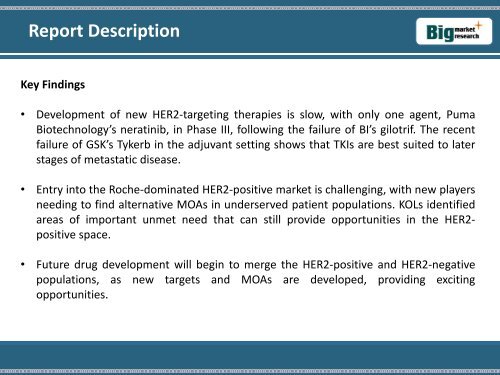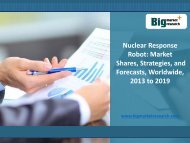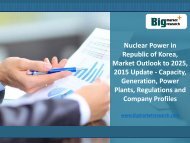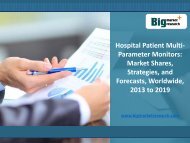PharmaPoint: HER2-Positive Breast Cancer Market, Global Drug Analysis to 2023
Big Market Research, Global PharmaPoint HER2-Positive Breast Cancer Drug Market Size, Share, Trends, Application, Forecast, Demand, Analysis, Research, Report, Opportunities, Segmentation, to 2023. Browse complete report & TOC @ http://www.bigmarketresearch.com/pharmapoint-her2-positive-breast-cancer-global-drug-forecast-and-analysis-to-2023-market HER2-positive breast cancer is the second most common cancer in the world and the most common cancer in women worldwide. This report focuses on the current treatment landscape, unmet needs, current pipeline, and commercial opportunities in the HER2-positive breast cancer market, with coverage of multiple settings of the disease including neoadjuvant, adjuvant, first-, second-, third-, and fourth-line metastatic. This report forecasts that the two monoclonal antibodies that also target the HER2 receptor will ensure Roche still occupies over 95% of the market in 2023. The challenge for new entrants into the HER2-positive market is to find patient populations that are currently underserved, and can work cooperatively with Roche’s targeted therapies. The HER2-positive breast cancer market will increase by 2.5-fold, reaching $12.63bn by 2023, at a CAGR of 9.82%, driven by the rapid uptake of the latest premium-priced biologics. By 2023, the largest market segment will be the adjuvant setting, with rapid growth at a CAGR of 12.3%, and representing 63% of the total HER2-positive market. Herceptin will no longer be the market leader, with new agents Perjeta and Kadcyla taking 37% and 39% market share respectively.
Big Market Research, Global PharmaPoint HER2-Positive Breast Cancer Drug Market Size, Share, Trends, Application, Forecast, Demand, Analysis, Research, Report, Opportunities, Segmentation, to 2023. Browse complete report & TOC @ http://www.bigmarketresearch.com/pharmapoint-her2-positive-breast-cancer-global-drug-forecast-and-analysis-to-2023-market
HER2-positive breast cancer is the second most common cancer in the world and the most common cancer in women worldwide. This report focuses on the current treatment landscape, unmet needs, current pipeline, and commercial opportunities in the HER2-positive breast cancer market, with coverage of multiple settings of the disease including neoadjuvant, adjuvant, first-, second-, third-, and fourth-line metastatic. This report forecasts that the two monoclonal antibodies that also target the HER2 receptor will ensure Roche still occupies over 95% of the market in 2023. The challenge for new entrants into the HER2-positive market is to find patient populations that are currently underserved, and can work cooperatively with Roche’s targeted therapies. The HER2-positive breast cancer market will increase by 2.5-fold, reaching $12.63bn by 2023, at a CAGR of 9.82%, driven by the rapid uptake of the latest premium-priced biologics.
By 2023, the largest market segment will be the adjuvant setting, with rapid growth at a CAGR of 12.3%, and representing 63% of the total HER2-positive market. Herceptin will no longer be the market leader, with new agents Perjeta and Kadcyla taking 37% and 39% market share respectively.
Create successful ePaper yourself
Turn your PDF publications into a flip-book with our unique Google optimized e-Paper software.
Report Description<br />
Key Findings<br />
• Development of new <strong>HER2</strong>-targeting therapies is slow, with only one agent, Puma<br />
Biotechnology’s neratinib, in Phase III, following the failure of BI’s gilotrif. The recent<br />
failure of GSK’s Tykerb in the adjuvant setting shows that TKIs are best suited <strong>to</strong> later<br />
stages of metastatic disease.<br />
• Entry in<strong>to</strong> the Roche-dominated <strong>HER2</strong>-positive market is challenging, with new players<br />
needing <strong>to</strong> find alternative MOAs in underserved patient populations. KOLs identified<br />
areas of important unmet need that can still provide opportunities in the <strong>HER2</strong>-<br />
positive space.<br />
• Future drug development will begin <strong>to</strong> merge the <strong>HER2</strong>-positive and <strong>HER2</strong>-negative<br />
populations, as new targets and MOAs are developed, providing exciting<br />
opportunities.

















